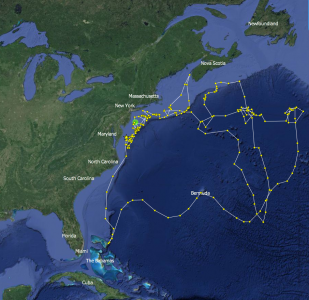NSU Newsroom
SharkBytes
Horizons
This version of NSU News has been archived as of February 28, 2019. To search through archived articles, visit nova.edu/search. To access the new version of NSU News, visit news.nova.edu.
This version of SharkBytes has been archived as of February 28, 2019. To search through archived articles, visit nova.edu/search. To access the new version of SharkBytes, visit sharkbytes.nova.edu.
Mako Shark Giving Regards To Broadway as She Swims off the Coast Of New York City
Six-Foot Mako Takes No Backseat to Great Whites in Logging Miles
NEW YORK, NY – The latest tourist swinging by New York City isn’t there to take a bite out of the “Big Apple” – she’s just visiting.
It’s a shortfin mako shark – a juvenile female who is just passing by on her epic travels. Fitted with a sophist icated SPOT satellite tag and tracked in near real-time on an online, interactive website hosted by Nova Southeastern University’s Guy Harvey Research Institute (GHRI), this little lady is skirting by NYC as she heads north on an amazing year’s journey that has, so far, covered more than 10,000 miles.
icated SPOT satellite tag and tracked in near real-time on an online, interactive website hosted by Nova Southeastern University’s Guy Harvey Research Institute (GHRI), this little lady is skirting by NYC as she heads north on an amazing year’s journey that has, so far, covered more than 10,000 miles.
The 140-pound, female shortfin mako, dubbed Jiffy Lube2, was tagged last May off Ocean City, Maryland. Scientists from the NSU’s GHRI tagged, released and tracked 13 makos in 2013 and 2014 off Ocean City, Maryland. Named for the sponsor of her SPOT tag, Jiffy Lube2’s journey has gone as far south as the Bahamas, then northeast to Bermuda, then deep into the North Atlantic where she turned back east to Nova Scotia, Canada and then south near Ocean City and is now in the vicinity of New York City, some 80 miles off the coast.
If she were a car, this mako shark would have had to visit her local Jiffy Lube three times for an oil change! You can follow Jiffy Lube2 on her travels online (www.ghritracking.org).
NSU’s GHRI scientists have special interest in understanding mako shark migratory behavior because this information is essential for proper fisheries management and conservation of this highly fished and internationally roving species, whose populations in some areas are declining.
Last May, NSU researchers tagged and released three males and two female makos – dubbed St. Mary’s, SOSF3, SOSF1, JiffyLube 1 and JiffyLube 2 – off Maryland as part of an ongoing migration study. This fast swimming species is under heavy fishing pressure – in fact, unfortunately several GHRI-tagged makos have been captured in commercial longline fisheries, including St. Mary’s, which was captured off Baltimore last month after traveling 9,200 miles.
###
About Nova Southeastern University (NSU): Located in beautiful Fort Lauderdale, Florida, NSU is a dynamic research institution dedicated to providing high-quality educational programs at the undergraduate, graduate and first-professional degrees levels. An independent, not-for-profit institution with approximately 25,000 students, NSU has campuses in Fort Lauderdale, Fort Myers, Jacksonville, Miami, Miramar, Orlando, Palm Beach and Tampa, Florida as well as San Juan, Puerto Rico and online globally. For more than 50 years, NSU has been awarding degrees in a wide range of fields, while fostering groundbreaking research and an impactful commitment to community. Classified as a research university with “high research activity” by the Carnegie Foundation for the Advancement of Teaching, NSU is one of only 37 universities nationwide to also be awarded Carnegie’s Community Engagement Classification. For more information, please visit www.nova.edu
About NSU’s Halmos College of Natural Sciences and Oceanography: The college provides high-quality undergraduate and graduate education programs (i.e. doctoral, master’s, certificate) in a broad range of disciplines, including marine sciences, mathematics, physics and chemistry. Researchers carry out innovative, basic and applied marine and research programs in coral reel biology, ecology, and geology; fish biology, ecology, and conservation; shark and billfish ecology; fisheries science; deep sea organismal biology and ecology; invertebrate and vertebrate genomics, genetics, molecular ecology, and evolution; microbiology; biodiversity; observation and modeling of large scale ocean circulation, coastal dynamics, and ocean atmosphere coupling; benthic habitat mapping; biodiversity; histology; and calcification. The college’s newest building is the state-of-the-art Guy Harvey Oceanographic Center, an 86,000 square foot structure filled with laboratories, offices, seminar rooms, an auditorium and indoor and outdoor running sea water facilities. For more information, please visit http://www.nova.edu/ocean
About NSU’s Guy Harvey Research Institute: Established in 1999, the Guy Harvey Research Institute (GHRI) is a collaboration between the renowned marine artist, scientist and explorer, Dr. Guy Harvey, and Nova Southeastern University’s Oceanographic Center. The mission of the GHRI is to provide the scientific information necessary to understand, conserve, and effectively manage the world’s marine fishes and their ecosystems. The GHRI is one of only a handful of private organizations dedicated exclusively to the science-based conservation of marine fish populations and biodiversity. The research, education and outreach activities of the GHRI are supported by the Guy Harvey Ocean Foundation, AFTCO Inc., extramural research grants, philanthropic donations by private businesses and individuals, and NSU. For more information, please visit http://www.nova.edu/ocean/ghri/index.html
Media Contact
Joe Donzelli
Associate Director / Public Affairs
954-262-2159 (o)
954-661-4571 (c)
jdonzelli@nova.edu